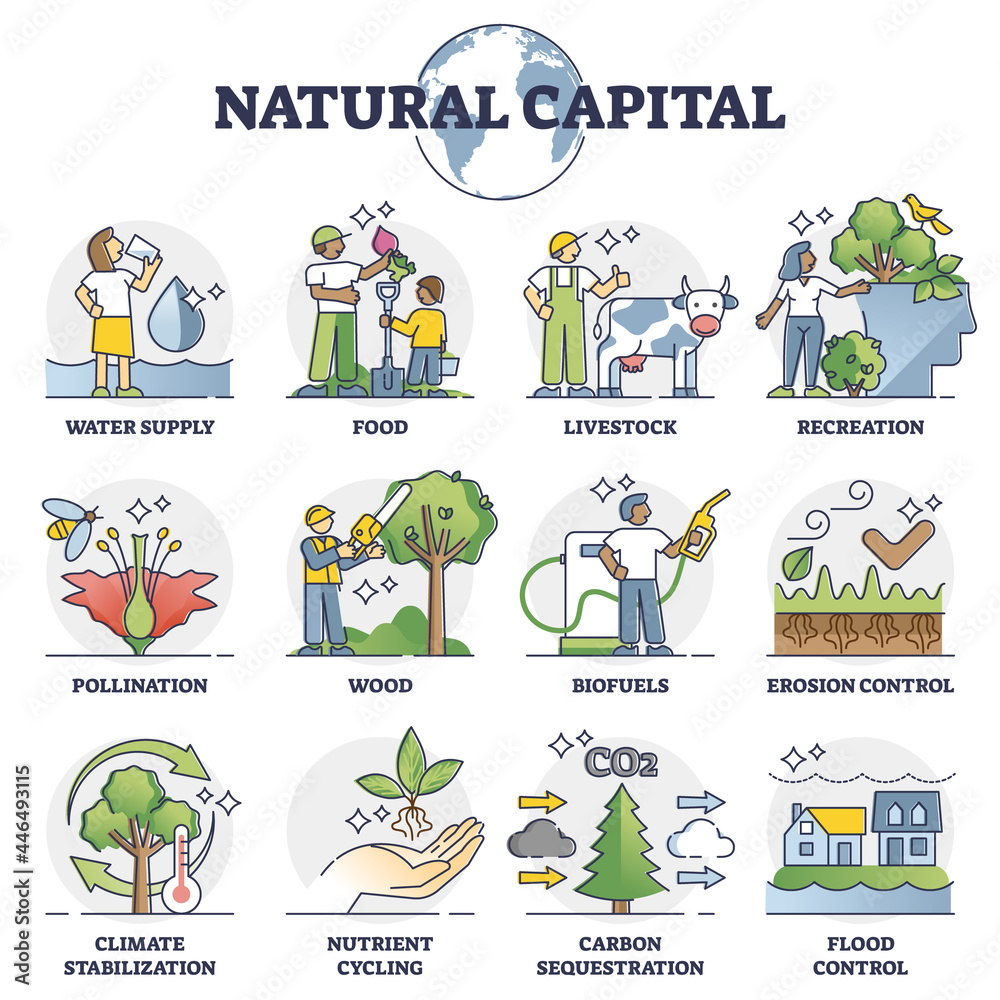
Natural Capital: Valuing Our Environmental Assets – A Beginner’s Guide to Sustainable Futures
Have you ever stopped to think about the true cost of the clean air you breathe, the fresh water you drink, or the fertile soil that grows your food? In our modern economy, we often track financial assets, physical infrastructure, and human skills. But what about the fundamental resources that underpin all life and economic activity? This is where the concept of Natural Capital comes in – a revolutionary way of thinking that recognizes the immense, often unseen, value of our planet’s environmental assets.
In an era of climate change, resource scarcity, and biodiversity loss, understanding and valuing Natural Capital isn’t just an academic exercise; it’s essential for building a truly sustainable future. This comprehensive guide will break down what Natural Capital is, why it matters, and how recognizing its value can transform our decisions for the better.
What Exactly is Natural Capital?
Imagine the Earth as a giant bank. Just like a financial bank has money, investments, and other assets, our planet holds a vast array of natural resources. Natural Capital refers to the stocks of natural assets that provide benefits to humanity. These "assets" aren’t just pretty landscapes; they are the fundamental building blocks of our environment and economy.
Think of it this way:
- Financial Capital: Money, stocks, bonds, factories, machinery.
- Human Capital: People’s skills, knowledge, health.
- Social Capital: Networks, trust, community bonds.
- Natural Capital: The actual environmental resources and systems.
These natural assets provide a continuous flow of goods and services, much like interest earned on a financial investment. If we deplete the principal (the natural capital stock), the interest (the flow of benefits) will eventually dry up.
Examples of Natural Capital Assets:
- Forests: Trees, soil, biodiversity.
- Oceans & Coasts: Marine life, coral reefs, mangroves, estuaries.
- Rivers & Lakes: Water bodies, aquatic species.
- Soils: Fertile land, microorganisms.
- Atmosphere: Air quality, climate regulation.
- Biodiversity: The variety of life on Earth (plants, animals, fungi, microorganisms).
- Minerals & Fossil Fuels: Non-renewable resources.
Understanding Ecosystem Services: The "Interest" from Our Natural Capital
While Natural Capital refers to the stock of assets, Ecosystem Services are the benefits that humans receive from ecosystems. These are the "returns" or "dividends" that our Natural Capital provides, often for free, and without which human life and economies would struggle to function.
Scientists typically categorize Ecosystem Services into four main types:
-
Provisioning Services: These are the direct products we obtain from ecosystems.
- Food: Crops, livestock, fish, wild game.
- Fresh Water: For drinking, irrigation, industry.
- Timber & Fibers: Wood for construction, paper; cotton, wool.
- Fuel: Biomass, wood for energy.
- Genetic Resources: Basis for new medicines, crops, and materials.
- Natural Medicines: Plants and animals providing pharmaceutical compounds.
-
Regulating Services: These are the benefits obtained from the regulation of ecosystem processes.
- Climate Regulation: Forests absorbing CO2, oceans regulating temperature.
- Water Purification: Wetlands filtering pollutants, forests regulating water flow.
- Air Quality Regulation: Plants removing pollutants from the air.
- Pollination: Bees, birds, and other animals pollinating crops.
- Pest & Disease Control: Natural predators controlling pest populations.
- Erosion Control: Vegetation preventing soil loss.
- Natural Hazard Regulation: Mangroves protecting coastlines from storms, wetlands absorbing floodwaters.
-
Cultural Services: These are the non-material benefits people gain from ecosystems through spiritual enrichment, recreation, and aesthetic experiences.
- Recreation & Tourism: Hiking, birdwatching, fishing, beach holidays.
- Aesthetic Value: Beautiful landscapes inspiring art and design.
- Spiritual & Religious Value: Sacred sites in nature.
- Mental & Physical Health: Access to green spaces improving well-being.
- Educational & Scientific Value: Opportunities for learning and research.
-
Supporting Services: These are the fundamental processes necessary for the production of all other ecosystem services. They operate on long time scales and are often unseen.
- Nutrient Cycling: Decomposition and recycling of essential nutrients (e.g., nitrogen, phosphorus).
- Soil Formation: The long process of creating fertile topsoil.
- Primary Production: Photosynthesis by plants forming the base of the food web.
- Water Cycling: The continuous movement of water on, above, and below the surface of the Earth.
Why Should We Value Natural Capital? The Unseen Costs of Neglect
For too long, the services provided by nature have been treated as "free goods," external to our economic calculations. This has led to a dangerous misconception: that we can exploit natural resources indefinitely without consequence. However, the costs of degrading our Natural Capital are becoming painfully clear.
Valuing Natural Capital offers several critical advantages:
- Revealing Hidden Costs and Benefits: When we clear a forest, we see the immediate economic gain from timber. But we often ignore the loss of clean water filtration, carbon sequestration, biodiversity habitat, and recreational opportunities. Valuing these "hidden" services makes the true cost-benefit analysis clearer.
- Informing Better Decision-Making: If a proposed development project threatens a wetland, knowing the economic value of that wetland’s flood protection and water purification services can lead to more sustainable alternatives or mitigation efforts. It allows us to compare apples to apples – or rather, development profits to ecosystem service losses.
- Driving Sustainable Investment: Once nature’s value is quantified, it becomes an asset worthy of investment. Companies and governments can see the financial sense in restoring wetlands, planting forests, or protecting coral reefs because they understand the returns in terms of avoided costs (e.g., less flood damage) or new revenue streams (e.g., ecotourism).
- Mitigating Risks: Ecosystem degradation increases risks. Loss of natural flood barriers leads to higher flood damage. Loss of pollinators threatens food security. Valuing Natural Capital helps identify and reduce these environmental and economic risks.
- Promoting Accountability: If an industry pollutes a river, valuing the cost of water purification and lost fisheries can hold them accountable for the damage they cause, encouraging more responsible practices.
- Enhancing Long-Term Resilience: Economies and societies that depend on healthy ecosystems are more resilient to shocks like climate change, natural disasters, and resource scarcity. Investing in Natural Capital is investing in long-term stability.
- Meeting Global Goals: Valuing natural capital is crucial for achieving the United Nations Sustainable Development Goals (SDGs), particularly those related to clean water, life on land, life below water, and climate action.
The Challenge: Undervaluation and Degradation
The primary challenge is that Natural Capital and Ecosystem Services are largely unpriced in conventional markets. They don’t appear on balance sheets, and their degradation doesn’t directly show up as a loss in GDP (Gross Domestic Product). This invisibility leads to:
- Market Failures: Economic decisions are made without considering the full environmental costs or benefits.
- Short-Term Thinking: Emphasis on immediate profits often outweighs long-term environmental sustainability.
- Policy Gaps: Policies are often created without a comprehensive understanding of the environmental impacts.
- "Tragedy of the Commons": Shared natural resources are overused or degraded because no one individual has a clear incentive to protect them.
As a result, we’re depleting our Natural Capital at an alarming rate, akin to spending the principal of our planet’s bank account without replenishing it.
How Do We Value Natural Capital? Beyond Just Money
Valuing Natural Capital isn’t always about putting a precise dollar figure on a tree or a river. It’s about making the benefits and costs visible, understandable, and comparable. It involves a range of approaches:
-
Monetary Valuation: Assigning a financial value to ecosystem services. This can be done through:
- Market Pricing: For services that have a direct market (e.g., timber, fish).
- Avoided Costs: Calculating the costs saved by a natural service (e.g., cost of building a water treatment plant vs. using a natural wetland for filtration).
- Replacement Costs: How much would it cost to artificially replace a natural service (e.g., building sea walls vs. protecting mangroves for coastal protection).
- Stated Preference Methods: Asking people what they would be willing to pay for a service or accept for its loss (e.g., surveys for recreational value).
- Revealed Preference Methods: Inferring value from people’s actual behavior (e.g., how much people spend to visit a natural park).
-
Biophysical Valuation: Quantifying the physical amount of services provided (e.g., tons of carbon sequestered, cubic meters of water filtered, number of pollinated crops). This is often the first step before monetary valuation.
-
Social & Cultural Valuation: Recognizing the non-monetary values that communities and individuals place on nature, such as spiritual significance, aesthetic beauty, or cultural heritage. These values are crucial and often cannot be fully captured by monetary metrics.
The goal is not necessarily to "price nature" in a transactional sense, but to integrate nature’s value into decision-making processes so that its benefits are recognized and its degradation is accounted for.
Natural Capital in Action: Real-World Examples
Across the globe, governments, businesses, and communities are starting to embrace Natural Capital principles:
- New York City’s Water Supply: Instead of building a multi-billion-dollar water filtration plant, NYC invested hundreds of millions in protecting and restoring the Catskill Mountains watershed. The healthy ecosystem naturally filters the city’s drinking water, saving taxpayers billions and providing ongoing environmental benefits.
- Costa Rica’s Payments for Environmental Services (PES): Costa Rica implemented a program where landowners are paid to conserve forests and provide ecosystem services like water purification, biodiversity protection, and carbon sequestration. This incentivizes conservation and sustainable land management.
- Unilever’s Sustainable Sourcing: As a consumer goods giant, Unilever depends heavily on natural resources. They are investing in sustainable sourcing practices for ingredients like palm oil, tea, and cocoa, recognizing that a healthy environment is critical for their long-term supply chain and business resilience.
- The UK’s Natural Capital Accounts: The UK government is developing national natural capital accounts to measure the extent, condition, and services provided by its natural assets. This helps inform policy decisions and track progress towards environmental goals.
- The Valuing Nature Programme (Various Countries): Initiatives globally are bringing together researchers, policymakers, and businesses to understand and demonstrate the value of nature, fostering interdisciplinary collaboration.
These examples highlight a shift from viewing nature as something separate from the economy to recognizing it as an integral and invaluable asset.
Benefits of Fully Valuing Our Natural Capital
Embracing Natural Capital accounting and valuation offers a wealth of benefits:
- Improved Risk Management: Better understanding of environmental dependencies helps identify and mitigate risks to businesses and communities.
- Enhanced Investment Decisions: Directing capital towards projects that enhance, rather than degrade, natural assets, leading to more sustainable returns.
- Innovation and Green Growth: Stimulating the development of new technologies and business models that work in harmony with nature.
- Greater Accountability and Transparency: Making environmental impacts visible on balance sheets encourages more responsible corporate and governmental behavior.
- Stronger Policy and Regulation: Designing more effective environmental policies based on a clear understanding of costs and benefits.
- Increased Public Awareness and Engagement: Fostering a deeper appreciation for nature and encouraging individual actions for conservation.
- Better Human Well-being: Ultimately leading to healthier environments that support human health, happiness, and prosperity.
Moving Forward: What Can We Do?
Integrating Natural Capital into our economic and societal fabric is a journey, but it’s one we must embark on with urgency.
-
For Governments and Policymakers:
- Develop national and regional natural capital accounts.
- Integrate natural capital considerations into economic planning and infrastructure projects.
- Implement policies that internalize environmental costs (e.g., carbon pricing, pollution taxes).
- Invest in nature-based solutions for infrastructure challenges.
-
For Businesses and Investors:
- Assess and disclose their dependency and impact on natural capital.
- Incorporate natural capital risks and opportunities into financial reporting.
- Invest in sustainable supply chains and restorative practices.
- Explore new business models that generate positive environmental impacts.
-
For Individuals:
- Understand your own dependence on natural capital (e.g., where does your water come from? What pollinates your food?).
- Support businesses and policies that value and protect nature.
- Participate in local conservation efforts.
- Educate yourself and others about the importance of natural capital.
-
For Researchers and Academics:
- Continue to refine valuation methodologies.
- Improve data collection and mapping of ecosystem services.
- Translate complex scientific findings into actionable insights for decision-makers.
Conclusion: Investing in Nature is Investing in Ourselves
Natural Capital is not just an environmental concept; it’s an economic imperative. By recognizing and valuing our environmental assets – the clean air, fresh water, fertile soils, and rich biodiversity that sustain us – we can transition from a destructive, extractive economy to one that is regenerative and truly sustainable.
It’s time to shift our perspective: from seeing nature as an endless resource to be exploited, to understanding it as our most precious capital asset, worthy of investment, protection, and careful stewardship. The future of our planet, our economies, and our well-being depends on it. Let’s start valuing what truly matters.



Post Comment